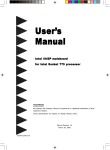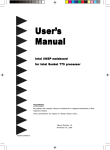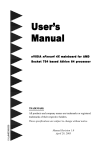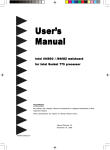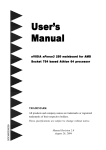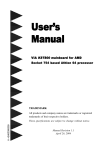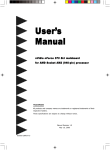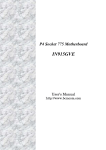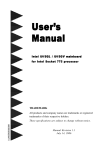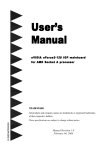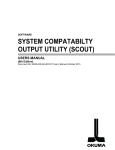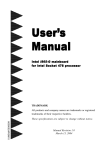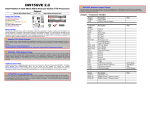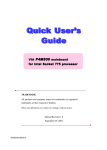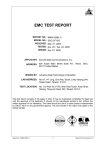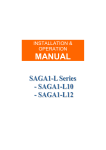Download User`s Manual
Transcript
User’s Manual nVidia nForce4 Ultra / nForce4 4X mainboard ocessor f or AMD Soc ket AM2 (940-pin) pr Sock processor TRADEMARK All products and company names are trademarks or registered trademarks of their respective holders. These specifications are subject to change without notice. Manual Revision 1.0 June 20, 2006 6000012MF4310 DISCLAIMER OF WARRANTIES: THERE ARE NO WARRANTIES WHICH EXTEND BEYOND THE DESCRIPTION ON THE FACE OF THE MANUFACTURER LIMITED WARRANTY. THE MANUFACTURER EXPRESSLY EXCLUDES ALL OTHER WARRANTIES, EXPRESS OR IMPLIED, REGARDING ITS PRODUCTS; INCLUDING ANY IMPLIED WARRANTIES OF MERCHANTABILITY, FITNESS FOR A PARTICULAR PURPOSE OR NONINFRINGEMENT. THIS DISCLAIMER OF WARRANTIES SHALL APPLY TO THE EXTENT ALLOWED UNDER LOCAL LAWS IN THE COUNTRY PURCHASED IN WHICH LOCAL LAWS DO NOT ALLOW OR LIMIT THE EXCLUSION OF THE IMPLIED WARRANTIES. HANDLING PROCEDURES: Static electricity can severely damage your equipment. Handle the mainboard and any other device in your system with extreme care and avoid unnecessary contact with system components on the mainboard. Always work on an antistatic surface to avoid possible damage to the mainboard from static discharge. Always have the power supply unplugged and powered off when inserting and removing devices within the computer chassis. The Manufacturer assumes no responsibility for any damage to the mainboard that results from failure to follow instruction or failure to observe safety precautions. CAUTION The mainboard is subject to damage by static electricity. Always observe the handling procedures. ii Post Port Frequently Asked Questions Below is a list of some basic POST Codes, possible problems and solutions. For more detailed information about POST Codes, refer to Appendix in this manual. Post Code FFh or CFh Problem Solution 1. BIOS chip inserted incorrectly 1. Reinsert the BIOS chip 2. Incorrect BIOS update version 2. Download the correct BIOS version update from the manufacturer's Web site 3. Mainboard problem 4. Add-on card inserted incorrectly 3. Replace mainboard 4. Remove and replace the add-on card C1h - C5h 2Dh 26h 07h - 12h 1. Memory module inserted incorrectly 1. Reinsert memroy module 2. Memory compatibility problem 2. Replace memory with correct type 3. Memory module damaged 3. Replace memory module 1. Error occured in VGA BIOS 1. Replace VGA card 2. VGA card inserted incorrectly 2. Reinsert the VGA card Overclock error Clear CMOS or press the insert key to power on the system 1. Initial Keyboard controller error 1. Ensure the Keyboard and mouse are 2. RTC error connected correctly 2. Replace the RTC battery iii Table of Contents Page Section 1-- Introduction ............................................................................ 1 1-1 Package Contents ................................................................................ 1 1-2 Mainboard Features .............................................................................. 2 1-3 Mainboard Specification ......................................................................... 4 1-4 System Block Diagram ........................................................................... 6 Section 2-- Installation ............................................................................... 7 2-1 CPU Installation .................................................................................... 8 2-2 Jumper Settings ................................................................................... 8 2-3 System Memory Configuration ............................................................... 9 2-4 Rear I/O Port ........................................................................................ 10 2-5 Internal Connectors .............................................................................. 10 Section 3-- BIOS Setup ............................................................................ 13 3-1 Main Menu ............................................................................................ 13 3-2 Standard CMOS Setup .......................................................................... 14 3-3 Advanced BIOS Features ...................................................................... 14 3-4 Power BIOS Features ............................................................................ 16 Section 4-- Driver & Utility ........................................................................ 18 Section 5-- Ghost BIOS ............................................................................ 19 Section 6-- Appendix ................................................................................. 21 6-1 Post Codes ........................................................................................... 21 iv Introduction Section 1 -- Introduction 1-1 Package Contents Contents English Optional items A . Mainboard H. Extra USB2.0 port cable B. User’s manual I. Thermo Stick cable C . Floppy drive cable If you need the optional item, please contact your dealer for assistance. D. HDD drive cable E. CD (drivers and utilities) F. I/O Shield G. SATA data cable USER’S MANUAL E C F D A G B H I If you intend to setup RAID: When installing Windows XP/2000 into any RAID drive, the O/S setup will require a floppy disk containing the RAID driver. This step will show you how to prepare this driver floppy. 1. Locate a PC and insert the bundled CD into its CD-ROM drive. 2. A main menu screen will appear (Autorun feature) 3. Select the page “RAID floppy” 4. Insert a blank floppy into the A:drive 5. Click on the required RAID controller driver to begin copy into the floppy 1 Introduction 1-2 Mainboard Features Brief Introduction Socket AM2 English Socket AM2 (940-pin) based motherboards are designed to provide performance enhancements for AMD Athlon AM2 processor-based systems, and it also expected to be the next-generation of platform innovations. For more information about all the new features AthlonTM AM2 Processor deliver, check out the AMD website at http://www.amd.com Chipset The board is designed with nVidia nForce4 Ultra/nForce4 4X chipset, featuring performance and stability with the most innovative technology and features. For more details about the nVidia chipset, please visit the nVidia Web site at http://www.nVidia.com. PCI-Express (PCI-E) Next generation peripheral interface to succeed to current PCI bus for the next decade. With smaller slot size and 250MB/sec (PCI-E*1) or 4GB/sec(PCI-E*16) maximum transfer, PCI-Express overcomes PCI bus bottleneck. DDR2 DDR2 ushers in the new era of DDR memory technology. DDR2 memory offers faster speed, higher data bandwidth and lower power consumption over DDR. Dual Channel Supports dual channel of DDR2 memory to give you twice the memory bandwidth for greater system performance. Hardware Monitoring Hardware monitoring enables you to monitor various aspects of the system operation and status. This includes CPU temperature, voltage and fan speed in RPMs. 10/100 LAN (Optional) This mainboard is mounted with a 10/100BASE-T Ethernet LAN controller. It allows the mainboard to connect to a local area network by means of a network hub. GbE LAN (Optional) This mainboard is mounted with the new Gigabit Ethernet LAN which allows data transmission at 1,000 megabits per second (Mbps), running at 10 times faster than conventional 10/100BASE-T Ethernet LANs. Serial ATA (Supported in the NVIDIA nForce4 4X chipset) Support Serial ATA, an evolutionary replacement for Parallel ATA IDE storage interface. Increases the peak data transfer speed up to 150MB/sec and allows future enhancements to the computing platform. Serial ATA II (Supported in the NVIDIA nForce4 Ultra chipset) S-ATA II is the second generation SATA interface with double the transferring speed up to 300MB/sec. It supports NCQ to provide faster reading speed for your storage devices. SATA RAID RAID function available on chipset’s SATA/SATA II ports, RAID 0, 1, 0+1, JBOD by NV driver support. USB2.0 A popular USB standard for plugging in peripherals with up to 480Mbps transfer speed while maintaining backward compatibility with older USB1.1 device. 6ch (Optional) Mainboard is equipped with 6 channel of audio to support Dolby Digital 5.1 audio for DVD-playback. The onboard audio jacks can be configured for normal 2 channel mode or 6 channel mode. 2 8ch (Optional) Delivers 8 channel audio to bring you the latest in audio realism from DVD movies and games. Perfect for your home theatre system. Introduction AMD Cool'n'QuietTM Technology AMD's Cool'n'QuietTM Technology lowers CPU operating voltage when the system is in idle mode. This helps to reduce heat dissipation and in effect lowers the fan speed to noise from your PC. English NVIDIA Firewall (Optional) An unprecedented addition design for nForce product, provide high performance & enhanced reliability of PC security solution to the users. The features would be more advanced than many stand-alone firewalls can provide! NVIDIA ActiveArmorTM (Supported in the NVIDIA nForce4 Ultra chipset) Enhances networks security while delivers the highest system performance by off-loading CPU-intensive packet filtering tasks in hardware, providing users with a PC networking environment that is both fast and secure. Special Features BIOS Features: Ghost BIOS No more worries if BIOS gets corrupted causing your system unable to boot. The onboard backup BIOS will rescue & recover main BIOS in just a few easy steps. Thunder Probe A hardware diagnostic software to monitor voltage, temperature and speed of a variety of hardware. It also includes an ingenious built in fan control feature called Smart Fan. Thunder Flash A Windows based innovation tool to provide safe and easy BIOS rescue function, BIOS flash function and personal start up screen. Magic Health Reports your system hardware status for every boot-up to help detect faults early. Monitor hardware status including CPU temperature, CPU/Memory/Chipset voltage, fan RPM speed for chassis fan, CPU fan & Power supply fan. EZ-Boot Simply press “ESC” to select your bootable device. No more hassle to search the BIOS menu, change and re-start. PowerBIOS Supporting a full range of overclocking setting via BIOS. Various adjustable feature include FSB/Memory/ Chipset voltage tweaking. H/W Features: Post Port An onboard LED-display trouble-shooting device, facilitating user to detect boot-up problems. QuickSPDIF On board SPDIF-out connector for quick connection to multi-channel speakers. Not only removes cable cluttering but also delivers loss-free digital audio to let you enjoy DVD movies and games with crystal clear sound. Thermo Stick (Optional) Flexible thermometer to let you measure any temperature by software. Ideal for monitoring VGA card, chipset or even disk drives temperatures. 3 Introduction 1-3 Mainboard Specification Processor Support Socket-AM2 (940 pin) based AMD Athlon-X2/Athlon-64/Sempron processors Support 2.0/1.6GTs 16X16 wide Hyper Transport bus English Support VMM (Virtualization-Machine-Monitoring) Chipset nVidia nForce4 Ultra / nForce4 4X Chipset Main Memory Four 240-pin DDR2 SDRAM DIMM sockets Support 1.8v DDR2-533/667/800 DIMMs with dual channel architecture Support single-sided or double-sided, unbuffered, non-ECC DIMMs with 256/512Mb/1Gb technologies Supports up to 16GB memory size Expansion Slots Three PCI connectors compliant with PCI v2.3 Two PCI-E (x1) connectors compliant with PCI Express 1.0a One PCI-E (x16) connectors compliant with PCI Express 1.0a USB Ten USB connectors compliant with USB2.0 from embedded USB controller (4 connectors at rear panel) LAN 10/100 Ethernet from onboard Realtek RTL8101E PCI-E controller (Optional) Gb Ethernet from onboard Realtek RTL8111B PCI-E controller (Optional) P-ATA IDE Two IDE interface (up to 4 IDE devices) with UDMA-33/66/100/133 support from embedded IDE controller S-ATA RAID Four S-ATA II ports with up to 300MB/s bandwidth with RAID 0, 1, 0+1 (Supported in the NVIDIA nForce4 Ultra chipset) Four S-ATA ports with up to 150MB/s bandwidth with RAID 0, 1, 0+1 (Supported in the NVIDIA nForce4 4x chipset) I/O Onboard EPoX EP1308 LPC bus I/O controller Legacy peripheral interface for PS/2 keyboard & mouse, FDD, Parallel, Serial, and IrDA (v1.0 compliant) Support Hardware Monitoring for fan speed monitoring and CPU temperature sensing Intelligent fan speed control for CPU-fan (PWM), Chassis-fan, Power-fan for quiet operation BIOS Flash EEPROM with Award Plug&Play BIOS Support EZ Boot for fast bootable device selection Support Magic Health for system hardware status report during system boot-up Support Ghost BIOS for BIOS Recovery Audio 8 channel audio from onboard Realtek ALC850 AC’97 v2.3 compliant CODEC (Optional) 6 channel audio from onboard Realtek ALC655 AC’97 v2.3 compliant CODEC (Optional) - Support CD-In, AUX-In 4 - Support Jack detection for fool-proof audio device installation Introduction - Rear panel audio jacks configuration: depending on model you purchased, please refer to one of the following table: 2 channel 6 channel Light Blue Line-in Rear stereo-out Lime Line-out Front stereo-out Pink Mic-in Center&Subwoofer Phone Jack Color 2 channel 6 channel Light Blue Line-in Line-in Line-in Lime Line-out Front stereo-out Front stereo-out Pink Mic-in Mic-in English For 6ch ALC655 Configuration Phone Jack Color For 8ch ALC850 Configuration Gray 8 channel Mic-in Side stereo-out Black Rear stereo-out Rear stereo-out Orange Center&Subwoofer Center&Subwoofer Peripheral Interfaces ) At Rear Panel PS/2 keyboard and mouse ports One Parallel (printer) port One S/PDIF-Out Coaxial jack One S/PDIF-Out Optical (Optional) One Serial port One RJ45 LAN connector Four USB2.0 ports Six Audio jacks or Three Audio jacks ) Onboard connector and pin-header One floppy drive connector Two ATA-100/133 IDE connectors Six extra USB2.0 ports One CD-IN and AUX-IN connectors One IR connector Four S-ATA II or S-ATA connectors Three Fan connectors Front Panel Controller Supports Reset & Soft-Off switches Supports HDD & Power LEDs Supports PC speaker Supports Front Panel Audio connector Special Features Support KBPO function – Keyboard power on, turn on the computer from keyboard Support Wake-On-LAN by PME Onboard Post Port LED display for system debugging PowerBIOS for excellent overclocking features: - Programmable FSB and PCI-E Clock output frequency with 1MHz fine tuning - Support BIOS adjustable CPU multiplier, FSB clock, DIMM frequency - Support BIOS adjustable CPU Core voltage, Chipset voltage and DIMM voltage Support Thermo Stick temperature (Optional) Support Ghost BIOS - Rescue, recover BIOS in an easy step and no more worry of BIOS being corrupted. 5 Introduction Powerful utilities for Windows Support Thunder Probe - A hardware diagnostic software to monitor voltage, temperature and speed of a variety of hardware. It also includes an ingenious built in fan control feature called Smart Fan. Support Thunder Flash - A Windows based innovation tool to provide safe and easy BIOS rescue function, BIOS flash function and personal start up screen. English Form Factor 305mm x 225 mm ATX size Supported O/S Windows 2000/Windows XP Depending on the model you purchased, some components are optional and may not be available. 1-4 System Block Diagram 6 Introduction Section 2 -- Installation English Always have the power supply unplugged and powered off when inserting and removing devices within the computer chassis. 2-1 CPU Installation Step 1 Open the socket by raising the actuation lever. Step 2 (1) Align pin 1 on the CPU with pin 1 on the CPU socket as shown. Insert the CPU and make sure it is fully inserted into the socket. (2) Close the socket by lowering and locking the actuation lever. (2) (1) The CPU is keyed to prevent incorrect insertion, do not force the CPU into the socket. If it does not go in easily, check for mis-orientation. Step 3 Insert the heatsink as shown. Press the clips in the direction of the arrows shown to secure the assembly to the CPU socket. Step 4 Plug the CPU fan power into the mainboard’s CPU fan connector. The installation is complete. • Thermal compound and qualified heatsink recommended by AMD are a must to avoid CPU overheat damage. • Apply heatsink thermal compound/paste to the CPU. 7 Introduction 2-2 Jumper Settings JCMOS: Clear CMOS data Jumper If the CMOS data becomes corrupted or you forgot the supervisor or user password, clear the CMOS data to reconfigure the system back to the default values stored in the ROM BIOS. English Settings: 1-2: Normal (Default) 2-3: Clear CMOS To CMOS Clear data, please follow the steps below. 1. Turn off the system. 2. Change the jumper from “1-2” to “2-3” position for a few seconds. 3. Replace the jumper back to the “1-2” position. 4. Turn on the system and hold down the <Del> key to enter BIOS setup. 8 Introduction 2-3 System Memory Configuration • Supports up to 16GB of 533/667/800MHz DDR2 SDRAM. • Supports unbuffered DIMM configurations defined in JEDEC DDR2 DIMM specification. English The mainboard accommodates Four 240-pin DIMMs. Dual Channel interface: • Dual channel memory access offers increased system performance. • For dual channel to operate, both channel must be populated with same amount of memory, preferably of the same type. • The four DIMM sockets are divided into two colors to help you identify the channel pairs <Figure 1>. Each dual channel pair has the same color, e.g. DIMM1 and DIMM2. To obtain best performance, simply mount DIMM sockets of the same color. <Figure 1> DIMM 1 Dual Channel 1 DIMM 2 Dual Channel 2 DIMM 4 Memory configurations supported: 1 DIMM (64-bit) DIMM#1 SS/DS 2 DIMM (64-bit) SS/DS DIMM#2 DIMM#3 SS/DS 2 DIMM (128-bit) 4 DIMM (128-bit) SS/DS SS/DS SS/DS SS/DS SS/DS DIMM#4 SS/DS SS/DS SS/DS SS/DS * SS: Single-Sided DIMM, DS: Double-Sided DIMM Memory Installation : To install, align the notch on the DIMM module with the connector. Press straight down as shown in the figure until the white clips close and the module fits tightly into the DIMM socket. Notch 9 Introduction 2-4 Rear IO Port The I/O back panel for this mainboard is shown below. When installing the mainboard into the computer case, use the bundled I/O shield to protect this back panel. RJ45 LAN Parallel Port English PS/2 or Mouse PS/2 Keyboard S/PDIF-out S/PDIF-out Coaxial Jack Optical (Optional) COM1 USB2.0 x 4 ports 5.1 Audio Channel 7.1 Audio Channel 2-5 Internal Connectors 4 1 5 3 6 9 11 3 10 10 7 2 8 1 Introduction Connectors Descriptions CPU / Power / Chassis Fan Power Connectors JCPU_FAN JPWR_FAN Control Ground Sense +12V JSYS_FAN JCPU_FAN: Connect the CPU fan to this connector. JPWR_FAN: Use this connector if you are installing an additional fan in the unit. JSYS_FAN: The chassis fan will provide adequate airflow throughout the chassis to prevent overheating the CPU. Ground Sense +12V 2 FDD 3 IDE1 Floppy Drive Connector 1 Primary/Secondary IDE Connector Connects to the IDE device, i.e. HDD and CD-ROM device. 1 Primary IDE When using two IDE drives on the same IDE2 connector, one must be set to Master mode and the other to Slave mode. Refer to your disk drive user’s manual for details. 1 Secondary IDE 23 24 3.3V 4 Ground +12V +5V +12V +5V 5VSB PW1 PW12 English 1 Figure 3 +12V Ground +5V 24-pin ATX Power Connector PW12: 4-pin ATX12V Power Connector The plugs of the power cables are designed to fit in only one orientation. +12V PW-OK Ground +5V Ground Ground Ground +5V PS-ON The PW1 and PW12 Power Connector must Ground 3.3V Ground -12V be used simultaneously. 4 1 2 -5V Ground Ground PW1: 3.3V 3.3V 1 11 1 MIC_In 2 5 GND +5V NC Front Line-out-R Rear Line-out-FR CFPA Key Rear Line-out-FL Front Line-out-L 9 10 CD_IN_Right 6 CD-IN AUX-IN CFPA: Front Panel Audio Connector This connector is used only if the speaker and microphone needs to be plugged at the front of the PC case. Otherwise, leave the jumpers at the default position. CD_Reference 1 CD_IN_Left CD-IN/AUX-IN: CD Audio-in connectors These connectors are used to receive audio from a CD-ROM drive, TV tuner or MPEG card. AUX_IN_Right GND 1 7 CUSB3 CUSB4 CUSB5 AUX_IN_Left CUSB3/CUSB4/CUSB5: Six USB2.0 header This mainboard includes 6 additional onboard USB ports. To use these additional USB ports, a USB bracket is required. Please contact your retailer for details. 11 Introduction Connectors Figure Descriptions CFP: Case Front Panel Connector 8 CFP HD_LED This LED indicates hard drive activity. English PWR_LED Connects to the power indicator on the PC case. RST Connects to the RESET switch on the PC case. PW_ON Connects to the Power button on the PC case, to turn on the system. To turn off the system, press the power button for 4 seconds. 9 CIR CIR: IR connector For connection to an IrDA receiver unit. CSPK CSPK: Speaker Connects to the case’s speaker for PC beeps. SATA1 SATA2 SATA3 SATA4 10 THM-ST (Optional) 11 CP80P 12 1 GND B+ BA- A+ GND GND SATA1 ~ SATA4: Four S-ATA II or S-ATA Connectors These connectors enable you to connect Serial ATA HDDs or optical drives type. Thermo Stick: Flexible thermometer to let you measure any temperature by software. Ideal for monitoring VGA card, chipset or even disk drives temperatures. CP80P: Post Port Debug LED Provides two-digit POST code to show why the system fail to boot. Allows quick and easy optimization. The LED will display the CPU temperature when you run the bundled Thunder Probe software. Introduction Section 3 -- BIOS Setup 3-1 Main Menu English The ROM BIOS contains a built-in Setup program which allows user to modify the basic system configuration and hardware parameters. The modified data is stored in a battery-backed CMOS, so that data will be retained even when the power is turned off. In general, the information saved in the CMOS RAM will stay unchanged unless there is a configuration change in the system, such as hard drive replacement or a device is added. It is possible for the CMOS battery to fail causing CMOS data loss. If this happens you will need install a new CMOS battery and reconfigure your BIOS settings. The BIOS setup screen and description are for reference only, and may not exactly match what you see on your screen. The contents of BIOS are subject to change without notice. Please visit our website for BIOS updates. To enter the Setup Program : Power on the computer and press the <Del> key during the POST (Power On Self Test). The BIOS CMOS SETUP UTILITY opens. The main menu displays all the major selection items. Select the item you need to reconfigure. The selection is made by moving the cursor, press any direction (arrow key ) to the item and pressing the ‘Enter’ key. An on-line help message is displayed at the bottom of the screen as the cursor is moved to various items which provides a better understanding of each function. When a selection is made, the menu of the selected item will appear so that the user can modify associated configuration parameters. For more information regarding BIOS settings refer to the complete manual in the bundled CD. 13 Introduction 3-2 Standard CMOS Setup Choose “STANDARD CMOS FEATURES” in the CMOS SETUP UTILITY Menu. Standard CMOS Features Setup allows the user to configure system settings such as the current date and time, type of hard disk drive installed, floppy drive type, and display type. Memory size is auto-detected by the BIOS and displayed for your reference. When a field is highlighted (use direction keys to move the cursor and the <Enter> key to select), the entries in the field can be changed by pressing the <PgDn> or the <PgUp> key. English Notes: • If the hard disk Primary Master/Slave and Secondary Master/Slave are set to Auto, the hard disk size and model will be auto-detected. • The “Halt On:” field is used to determine when the BIOS will halt the system if an error occurs. 3-3 Advanced BIOS Features Selecting the “ADVANCED BIOS FEATURES” option in the CMOS SETUP UTILITY menu allows users to change system related parameters in the displayed menu. This menu shows all of the manufacturer’s default values for the board. Pressing the [F1] key displays a help message for the selected item. Removable Device Priority This item allows you to select the hard disk boot priority. Options: Floppy Disk, LS120, ZIP100, USB-FDD0, USB-FDD1, USB-ZIP0, USB-ZIP1. Hard Disk Boot Priority This item allows you to select the hard disk boot priority. Options: Pri. Master, Pri. Slave, Sec. Master, Sec. Slave, USBHDD0, USBHDD1, USBHDD2, Bootable Add-in cards. CD-ROM Boot Priority This item allows you to select the CD-ROM boot priority. Options: Pri. Master, Pri. Slave, Sec. Master, Sec. Slave, USB-CDROM0, USB-CDROM1. 14 Introduction Init Display First This item is used to select whether to initialize the PCI-E or PCI first when the system boots. Options: PCI Slot, PCIEx. First /Second/Third Boot Device The BIOS attempts to load the operating system from the devices in the sequence selected in these items. Options: Floppy, LS120, Hard Disk, CDROM, ZIP100, USB-FDD, USB-ZIP, USB-CDROM, Legacy LAN, Disabled. English Boot Other Device When enabled, the system searches all other possible locations for an operating system if it fails to find one in the devices specified under the first, second, and third boot devices. Options: Enabled, Disabled. Boot Up Floppy Seek If this item is enabled, it checks the size of the floppy disk drives at start-up time. You don’t need to enable this item unless you have a legacy diskette drive with 360K capacity. Options: Enabled, Disabled. Boot Up NumLock Status This controls the state of the NumLock key when the system boots. On: The keypad acts as a 10-key pad. Off: The keypad acts like cursor keys. Security Option This category allows you to limit access to the System and Setup, or just to Setup. System: The system will not boot and access to Setup will be denied unless the correct password is entered at the prompt. Setup: The system will boot, but access to Setup will be denied unless the correct password is entered at the prompt. APIC Mode This item allows you to enable APIC (Advanced Programmable Interrupt Controller) functionality. Options: Enabled, Disabled. HDD S.M.A.R.T. Capability The S.M.A.R.T. (Self-Monitoring, Analysis, and Reporting Technology) system is a diagnostics technology that monitors and predicts device performance. S.M.A.R.T. Software resides on both the disk drive and the host computer. If a device failure is predicted, the host software, through the Client WORKS S.M.A.R.T applet, warns the user of the impending condition and advises appropriate action to protect the data. Options: Enabled, Disabled. Full Screen LOGO Show This item allows you determine Full Screen LOGO display during POST. Options: Enabled, Disabled. 15 Introduction 3-4 POWER BIOS Features This page lets you adjust various parameters to obtain improved performance for overclocking. Warning: English Overclocking requires expert knowledge and risks permanent damage to system components. We recommend you leave these parameters at their default values for proper operation. CPU Frequency Enables you to increment the CPU’s clock generator at 1 MHz step. This works together with CPU Clock Ratio (below) to set the CPU operating frequency. CPU Clock Generator x CPU Clock Ratio = CPU Frequency For example, if you have a processor that is rated at 2.4GHz and the clock generator is 200MHz, then 200MHz x 12 = 2.4GHz Options: 200 to 450 in 1MHz increments. Overclocking failure will cause no display on the monitor. To overcome this switch off the power supply and switch on again. Restart the system, press and hold <Insert> key. This will revert the BIOS to default or initial setting. PCIE Clock Enables you to subtle tune the PCI-E frequency at increments of 1MHz step. Options: 100 to 145 in 1MHz increments. CPU Clock Ratio Use this item to select a multiplier to set the CPU frequency. See CPU Frequency item above for explanation. If your CPU multiplier is locked this option will be unavailable. AMD K8 Cool’n’Quiet Reduce the noise and heat from your PC when AMD’s Cool’n’QuietTM technology is Auto. Options: Auto, Disabled. CPU Voltage This item allows you to adjust the CPU Vcore voltage. Options: Auto, -0.200V to +0.500V in 0.025V increments. We recommend that you leave this at the default value. Chipset Voltage This item allows you to adjust the Chipset voltage. Options: +1.5V to +1.8V in 0.1V increments. We recommend that you leave this at the default value. 16 Introduction DIMM Voltage This item allows you to adjust the DIMM slot voltage. Options: Auto, +1.8V to +2.5V in 0.1V increments. We recommend that you leave this at the default value. Memory clock This item sets the memory clock. DDRII 400 (200MHz) DDRII 533 (266MHz) DDRII 667 (333MHz) English CPU Core Clock Multiplier vs. DRAM Interface Speed DDRII 800 (400MHz) CPU Ratio CPU Frequency DIV Freq. DIV Freq. DIV Freq. DIV Freq. 4 0.8 GHz 5 160MHz 5 160MHz 5 160MHz 5 160MHz 5 1 GHz 5 200MHz 5 200MHz 5 200MHz 5 200MHz 6 1.2 GHz 6 200MHz 5 240MHz 5 240MHz 5 240MHz 7 1.4 GHz 7 200MHz 6 233MHz 5 280MHz 5 280MHz 8 1.6 GHz 8 200MHz 6 266MHz 5 320MHz 5 320MHz 9 1.8 GHz 9 200MHz 7 257MHz 6 300MHz 5 360MHz 10 2.0 GHz 10 200MHz 8 250MHz 6 333MHz 5 400MHz 11 2.2 GHz 11 200MHz 9 244MHz 7 314MHz 6 366MHz 12 2.4 GHz 12 200MHz 9 266MHz 8 300MHz 6 400MHz 13 2.6 GHz 13 200MHz 10 260MHz 8 325MHz 7 371MHz 14 2.8 GHz 14 200MHz 11 254MHz 9 311MHz 7 400MHz 15 3.0 GHz 15 200MHz 12 250MHz 9 333MHz 8 375MHz 16 3.2 GHz 16 200MHz 12 266MHz 10 320MHz 8 400MHz 17 3.4 GHz 17 200MHz 13 261MHz 11 309MHz 9 377MHz * Memory Frequency = CPU Frequency / Division For example, if you have a processor clock is 2GHz and the memory is DDRII 533 (266MHz), then the actual value of Memory clock is 2GHz / 8 = 250MHz. 17 Introduction Section 4 -- Driver & Utility Once the operating system has been installed, you need to install the drivers for the mainboard. English Please select: Method 1 Auto Installation Method 2 Manual Installation Please visit www.windowsupdate.com to update Windows XP before installing nVidia series driver >> nVIDIA nForce Driver >> REALTEK AUDIO Driver >> USB 2.0 Driver >> AMD Cool’n’Quiet Processor Driver Insert the bundled CD into the CD-ROM and the main menu screen will appear. The main menu displays links to the supported drivers, utilities and software. Method 1 This item installs all drivers automatically. Method 2 This item allows you to install the drivers selectively. Step 1 : Click “nVIDIA nForce Driver” to install chipset driver. Step 2 : Click “REALTEK AUDIO Driver” to install audio driver. Step 3 : Click “USB V2.0 Driver” to install USB 2.0 driver. Step 4 : Click “AMD Cool’n’Quiet Processor Driver” to install AMD series processor driver. Main menu items may vary depending on model you purchased. Once the drivers have been successfully installed, you may proceed to install the bundled utility software. 18 Introduction Section 5 -- Ghost BIOS Ghost BIOS helps you to recover from a corrupted BIOS situation, which normally would leave your system unable to boot. Ghost BIOS lets you repair the BIOS yourself saving the hassle of returning the mainboard for repair. English Preparing for Ghost BIOS: 1. Install the Thunder Flash utility found in the bundled CD. 2. Create a BIOS Recovery Disk (BRD) with this utility. “LOAD” Making BIOS Recovery Disk: 1. Run the Thunder Flash utility. 2. Connect to the internet. 3. Insert a blank floppy disk into floppy drive and click "LOAD". 4. Keep this floppy in a safe place for future use. If BIOS g ets cor gets corrr upted: When the BIOS is corrupted or fails, restart the system and this screen will appear. You may chose to recover the BIOS from BRD Floppy created earlier or from bundled driver CD. 1. If recover from BIOS Recovery Disk floppy, insert the floppy disk created earlier and click "1". 2. If recover from mainboard driver CD, insert driver CD into optical drive and click "2". Note that mainboard driver CD consists only of Safe Mode BIOS. Proper BIOS must be updated after you enter the O/S. 19 Introduction English If the screen below is shown, that means your BIOS version is not updated. Refer to Magic Flash steps to update the BIOS. 20 Introduction Section 6 -- Appendix POST (hex) DESCRIPTION CFh C0h Test CMOS R/W functionality. Early chipset initialization: - Disable shadow RAM - Disable L2 cache (socket 7 or below) - Program basic chipset registers Detect memory - Auto-detection of DRAM size, type and ECC. - Auto-detection of L2 cache (socket 7 or below) Expand compressed BIOS code to DRAM Call chipset hook to copy BIOS back to E000 & F000 shadow RAM. Expand the Xgroup codes locating in physical address 1000:0 Reserved Initial Superio_Early_Init switch. Reserved 1. Blank out screen 2. Clear CMOS error flag Reserved 1. Clear 8042 interface 2. Initialize 8042 self-test 1. Test special keyboard controller for Winbond 977 series Super I/O chips. 2. Enable keyboard interface. Reserved 1. Disable PS/2 mouse interface (optional). 2. Auto detect ports for keyboard & mouse followed by a port & interface swap (optional). 3. Reset keyboard for Winbond 977 series Super I/O chips. Reserved Test F000h segment shadow to see whether it is R/W-able or not. If test fails, keep beeping the speaker. Reserved Auto detect flash type to load appropriate flash R/W codes into the run time area in F000 for ESCD & DMI support. Reserved Use walking 1’s algorithm to check out interface in CMOS circuitry. Also set real-time clock power status, and then check for override. Reserved Program chipset default values into chipset. Chipset default values are MODBINable by OEM customers. Reserved Initial Early_Init_Onboard_Generator switch. Reserved Detect CPU information including brand, SMI type (Cyrix or Intel) and CPU level (586 or 686). Reserved Initial interrupts vector table. If no special specified, all H/W interrupts are directed to SPURIOUS_INT_HDLR & S/W interrupts to URIOUS_soft_HDLR. Reserved Initial EARLY_PM_INIT switch. Reserved Load keyboard matrix (notebook platform) Reserved C1h C3h C5h 01h 02h 03h 04h 05h 06h 07h 08h 09h 0Ah 0B-0Dh 0Eh 0Fh 10h 11h 12h 13h 14h 15h 16h 17h 18h 19-1Ah 1Bh 1Ch 1Dh 1Eh 1Fh 20h English 6-1 Post Codes 21 Introduction 21h 22h 23h English 24-26h 27h 28h 29h 2A-2Ch 2Dh 2E-32h 33h 34-3Bh 3Ch 3Dh 3Eh 3Fh 40h 41h 42h 43h 44h 45-46h 47h 48h 49h 4A-4Dh 4Eh 4Fh 50h 51h 52h 53-54h 55h 56h 57h 22 HPM initialization (notebook platform) Reserved 1. Check validity of RTC value: e.g. a value of 5Ah is an invalid value for RTC minute. 2. Load CMOS settings into BIOS stack. If CMOS checksum fails, use default value instead. 3. Prepare BIOS resource map for PCI & PnP use. If ESCD is valid, take into consideration of the ESCD’s legacy information. 4. Onboard clock generator initialization. Disable respective clock resource to empty PCI & DIMM slots. 5. Early PCI initialization: -Enumerate PCI bus number -Assign memory & I/O resource -Search for a valid VGA device & VGA BIOS, and put it into C000:0. Reserved Initialize INT 09 buffer Reserved 1. Program CPU internal MTRR (P6 & PII) for 0-640K memory address. 2. Initialize the APIC for Pentium class CPU. 3. Program early chipset according to CMOS setup. Example: onboard IDE controller. 4. Measure CPU speed. 5. Invoke video BIOS. Reserved 1. Initialize multi-language 2. Put information on screen display, including Award title, CPU type, CPU speed …. Reserved Reset keyboard except Winbond 977 series Super I/O chips. Reserved Test 8254 Reserved Test 8259 interrupt mask bits for channel 1. Reserved Test 8259 interrupt mask bits for channel 2. Reserved Reserved Test 8259 functionality. Reserved Reserved Initialize EISA slot Reserved 1. Calculate total memory by testing the last double word of each 64K page. 2. Program writes allocation for AMD K5 CPU. Reserved 1. Program MTRR of M1 CPU 2. Initialize L2 cache for P6 class CPU & program CPU with proper cacheable range. 3. Initialize the APIC for P6 class CPU. 4. On MP platform, adjust the cacheable range to smaller one in case the cacheable ranges between each CPU are not identical. Reserved Initialize USB Reserved Test all memory (clear all extended memory to 0) Reserved Display number of processors (multi-processor platform) Reserved 1. Display PnP logo 2. Early ISA PnP initialization Introduction 5E-5Fh 60h 61-64h 65h 66h 67h 68h 69h 6Ah 6Bh 6Ch 6Dh 6Eh 6Fh 70-72h 73h 74h 75h 76h 77h 78h-79h 7Ah 7B-7Eh 7Fh 80h-81h 82h 83h 84h 85h 86-92h -Assign CSN to every ISA PnP device. Reserved Initialize the combined Trend Anti-Virus code. Reserved (Optional Feature) Show message for entering AWDFLASH.EXE from FDD (optional) Reserved 1. Initialize Init_Onboard_Super_IO switch. 2. Initialize Init_Onbaord_AUDIO switch. Reserved Okay to enter Setup utility; i.e. not until this POST stage can users enter the CMOS setup utility. Reserved Initialize PS/2 Mouse Reserved Prepare memory size information for function call: INT 15h ax=E820h Reserved Turn on L2 cache Reserved Program chipset registers according to items described in Setup & Auto-configuration table. Reserved 1. Assign resources to all ISA PnP devices. 2. Auto assign ports to onboard COM ports if the corresponding item in Setup is set to “AUTO”. Reserved 1. Initialize floppy controller 2. Set up floppy related fields in 40:hardware. Reserved (Optional Feature) Enter AWDFLASH.EXE if : -AWDFLASH is found in floppy drive. -ALT+F2 is pressed Reserved Detect & install all IDE devices: HDD, LS120, ZIP, CDROM….. Reserved Detect serial ports & parallel ports. Reserved Detect & install co-processor Reserved 1. Switch back to text mode if full screen logo is supported. -If errors occur, report errors & wait for keys -If no errors occur or F1 key is pressed to continue: Clear EPA or customization logo. Reserved 1. Call chipset power management hook. 2. Recover the text font used by EPA logo (not for full screen logo) 3. If password is set, ask for password. Save all data in stack back to CMOS Initialize ISA PnP boot devices 1. USB final Initialization 2. NET PC: Build SYSID structure 3. Switch screen back to text mode 4. Set up ACPI table at top of memory. 5. Invoke ISA adapter ROMs 6. Assign IRQs to PCI devices 7. Initialize APM 8. Clear noise of IRQs. Reserved English 58h 59h 5Ah 5Bh 5Ch 5Dh 23 Introduction 93h 94h English 95h 96h FFh 24 Read HDD boot sector information for Trend Anti-Virus code 1. Enable L2 cache 2. Program boot up speed 3. Chipset final initialization. 4. Power management final initialization 5. Clear screen & display summary table 6. Program K6 write allocation 7. Program P6 class write combining 1. Program daylight saving 2. Update keyboard LED & typematic rate 1. Build MP table 2. Build & update ESCD 3. Set CMOS century to 20h or 19h 4. Load CMOS time into DOS timer tick 5. Build MSIRQ routing table. Boot attempt (INT 19h)




























